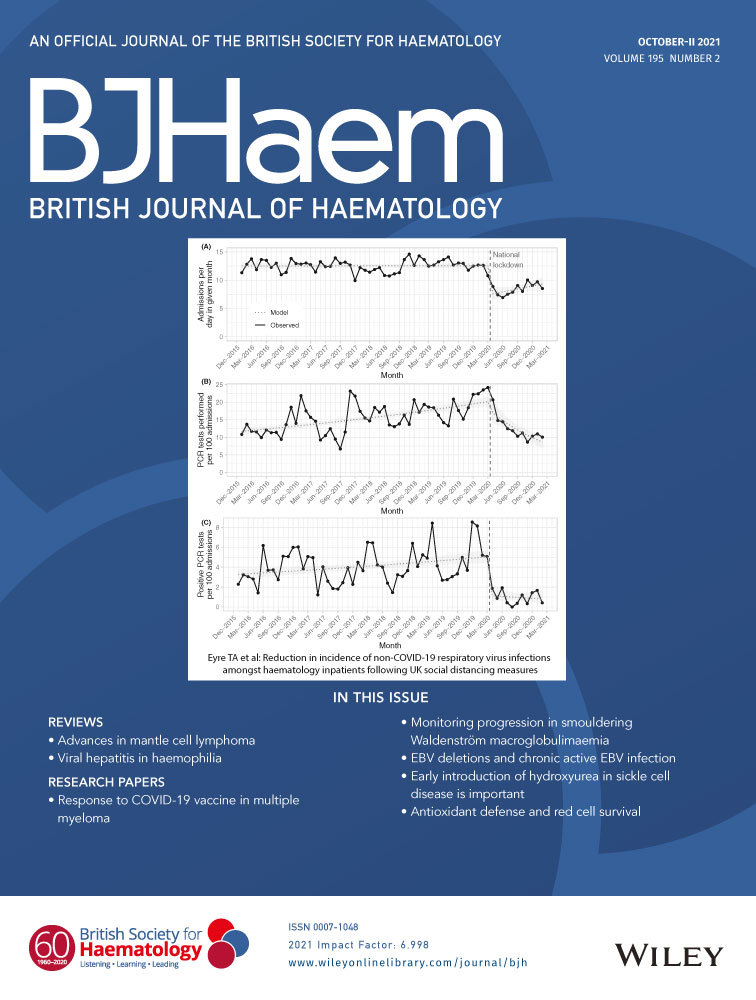A nationwide survey on central nervous system multiple myeloma in Japan: analysis of prognostic and treatment factors that impact survival
Takeshi Yamashita and Hiroyuki Takamatsu contributed equally.
Summary
This nationwide multicentre retrospective study was performed to analyze clinical features that predict the prognosis of central nervous system invasion in multiple myeloma (CNS-MM, approximately 1% of MM). Overall, of the 77 adult patients with CNS-MM identified between 2005 and 2016, those diagnosed at MM diagnosis (n = 3) had longer overall survival (OS) than those diagnosed at relapse (n = 74; median: 48·5 vs 2·7 months). Therefore, we compared the relapsed MM with CNS-MM in patients with any treatment (n = 60). Multivariate analyses revealed that lenalidomide treatment [hazard ratio (HR) 0·27, P = 0·003], intrathecal chemotherapy (IT; HR 0·54, P = 0·05), and radiation therapy (RTx; HR 0·33, P < 0·001) for CNS-MM had a positive effect on longer OS. These factors were used to develop a scoring system combining the number of treatments with lenalidomide, IT, and RTx (0, 1, 2, 3). The OS of CNS-MM patients was stratified based on these factors, with a median OS of 1·1, 4·5, and 7·5 months for patients with zero, one, two to three favourable features, respectively (0 vs 1, P = 0·0002; 1 vs 2–3, P = 0·08). Multimodal treatment including lenalidomide in addition to conventional IT and RTx can improve OS.
Conflicts of interest
HT received honoraria from Janssen, Bristol-Myers Squibb and Adaptive Biotechnologies; research funds from Janssen, Bristol-Myers Squibb, Ono and SRL. KS received honoraria from Celgene, Ono, Bristol-Myers Squibb, Takeda; research funds from Sanofi, AbbVie, Takeda, Bristol-Myers Squibb, Daiichi-Sankyo, Celgene, Alexion Pharma, Ono, Novartis, MSD, Astellas-Amgen, GlaxoSmithKline, and Janssen. TI received honoraria from Sanofi; research funds from Takeda and Sanofi. HH received honoraria from Janssen, Takeda, Ono, Celgene, Sanofi, Abbvie, Norvatis, Chugai, Kyowa Kirin, and Dai-ich Sankyo; research funds from Takeda, Celgene, Sanofi, Chugai, Kyowa Kirin, and Dai-ich Sankyo. YI received honoraria from Nippon Shinyaku, Celgene, SymBio Pharmaceuticals, Sanofi, Kyowa Kirin, Eizai, Bristol-Myers Squibb, and Sumitomo Dainippon Pharma. JK received honoraria from Bristol-Myers Squibb, Sanofi, Eizai, Nippon Shinyaku, Otsuka, Janssen, Takeda, Ono, Dai-ich Sankyo, Sumitomo Dainippon, Celgene, AbbVie, Chugai, Fujimoto, Astellas, and Asahi Kasei; research funds from Bristol-Myers Squibb, Celgene, Sysmex, Otsuka, GlaxoSmithKline, Nippon Shinyaku, Takeda, Astellas, Amgen, Chugai, Sanofi, Ono, Kyowa Kirin, Eizai, Asahi Kasei, Fujimoto, AbbVie, Japan Blood Products Organization, MSD, Dai-ich Sankyo, Sumitomo Dainippon, and Taiho. HN received honoraria from Eizai, Chugai, Mundipharma, Celgene, and Ono; Research funds from AstraZenec, Celgene, Zenyaku, Takeda, Chugai, Bayer, and Mundipharma. IH received honoraria and/or declares membership on an entity's board of directors, speakers’ bureau, or advisory committees from Celgene, Janssen, Takeda, Ono, Bristol-Myers Squibb, Novartis, Daiichi Sankyo, Kyowa Kirin, Eisai, Nihon-Shinyaku, Pfizer, AbbVie, Otsuka, Shionogi, Mundi, CSL Behring, and Merck Sharp & Dohme; research funds from Bristol-Myers Squibb, Ono, Kyowa Kirin, Sanofi, Takeda, and Celgene. SN received honoraria from Novartis, Kyowa Kirin and Alexion Pharma; is a member of advisory committees of SymBio Pharmaceuticals. SI received honoraria from Sanofi, Janssen, Takeda, Ono, Celgene and Daichi Sankyo; research funds from Celgene, Janssen, Ono, Takeda, Bristol-Myers Squibb, Chugai, Kyowa Kirin, Sanofi, Abbvie, Daiichi Sankyo, and GlaxoSmithKline. The other authors have no conflict of interests to declare.




